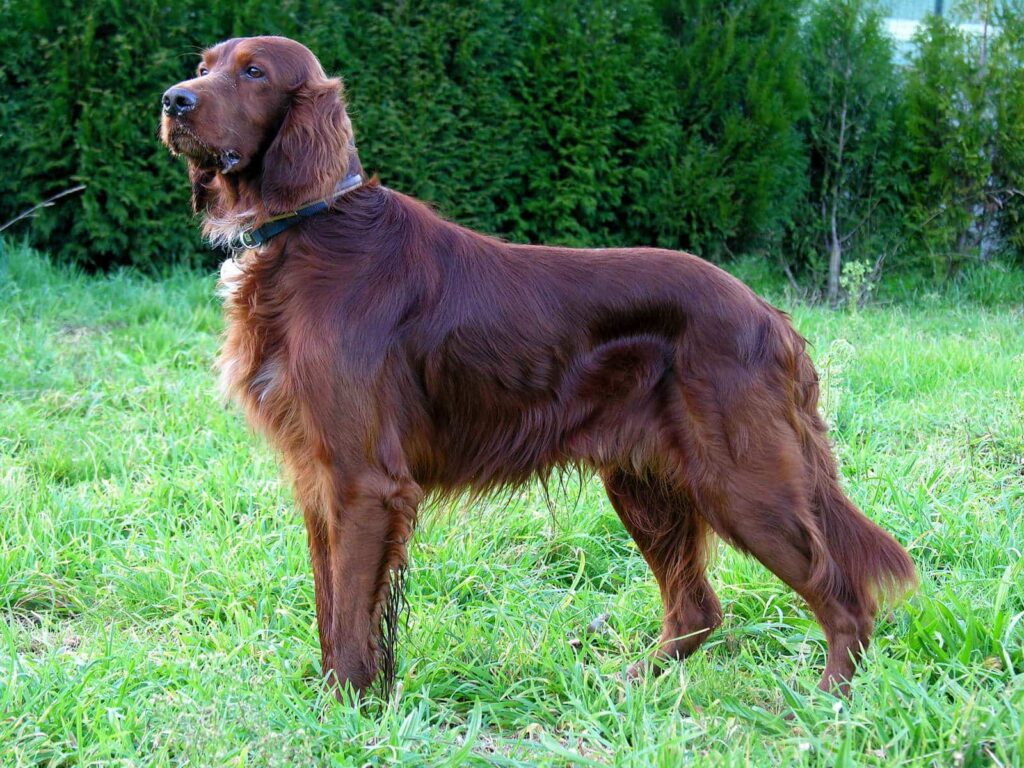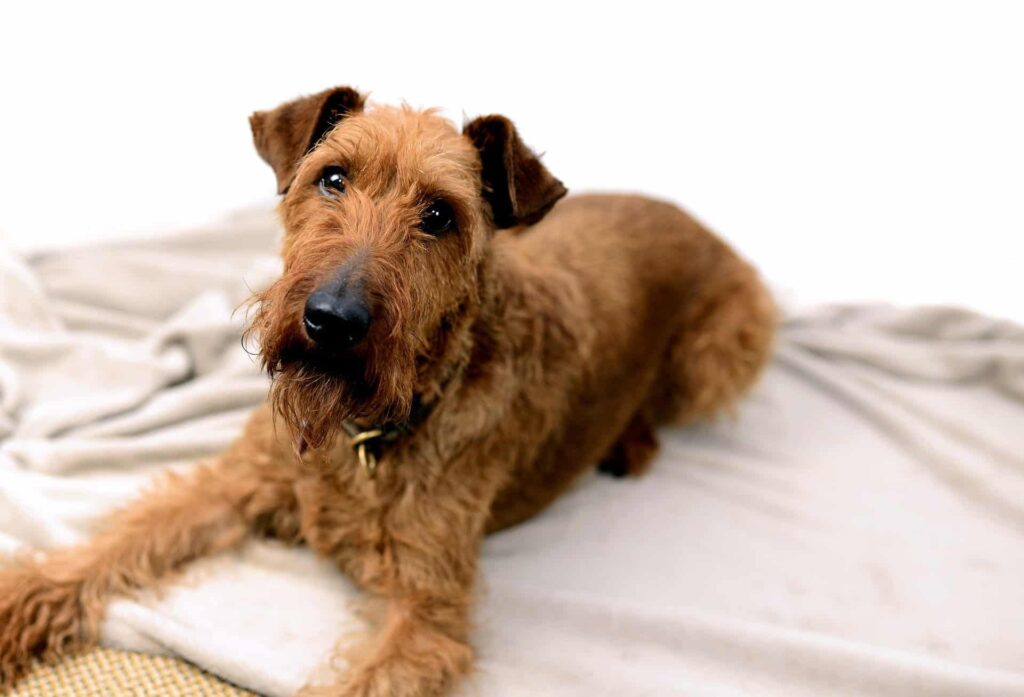Giving your new dog a name is no easy task when there are so many names to choose from! Luckily, you can start here with our list of the top ten adorable Irish dog names.

Ireland’s president Michael D Higgins has brought back the trend of Irish dog names with his beautiful Bernese Mountain dogs, ‘Bród’ (pride) and ‘Misneach’ (courage).
Let’s not forget his other dog, ‘Síoda’ (silk), whose death prompted a Dublin mural to be painted in her honour.
So, here are ten Irish dog names that are strong, musical, and, of course, adorable.
Rua – meaning ‘red’ (haired)

Yes, the Irish language has an adjective that means ‘red’ in colour but can only be used when referring to hair that is red.
Rua, pronounced like ‘roo-ah’, is the perfect name for an Irish red setter dog and one of the most adorable Irish dog names we can think of.
You might recognise this type of dog if you’ve ever travelled by Bus Éireann as each of their buses has a picture of an Irish red setter on the back.

Draíocht, pronounced ‘dree-ucht’, makes use of the throaty ‘ch’ sound. Once you’ve mastered it, you will sound like a true native Irish speaker.
Draíocht is literally a magical name, handpicked for dog owners who love Harry Potter and Lord of the Rings.
Hiúdaí – after the children’s TV character

Irish people who grew up in the ’90s and early 2000s will remember Hiúdaí (pronounced hew-dee) from TG4, Ireland’s Irish language TV channel.
Arguments would break out in the schoolyard about what exactly this animated creature was. Was Hiúdaí mostly human? A troll? A goat? Regardless, he always made us laugh.
The Tale of Cu Cuchulainn
The legend of Cú Chulainn is one of the greatest in Irish mythology. He is noted in Irish mythical sagas for his superhuman strength and amazing deeds on the battlefield.
His story was originally passed down by word of mouth, until it was written down more than 800 years ago in the Táin Bó Cúailnge. The story is so powerful that it is still taught in schools and written about today.
Cú Chulainn was an ancient Gaelic hero warrior who was gifted with superhuman strength, speed and skill. Setanta was his name as a young boy and his parents were Dechtire and Lugh. At the age of five Setanta left home to join the Red Branch Knights, the army of the king Conor Mac Nessa, who was his uncle. With him he took his hurley, his sliotar, his javelin and his spear. He would hit the sliotar with the hurley, leap forward and hit it a second time before it touched the ground, toss the javelin ahead and then the spear, run after them all, catch the ball and javelin with one hand and the spear with the other. When he reached the palace at Emain Macha, he beat 150 boys at hurling and other games.
Cú Chulainn achieved his name at the age of seven when he killed the watch dog of a blacksmith named Culann. One day Culann, who made spears for King Conor invited young Setanta to a feast. When Setanta arrived at Culann’s house his wolfhound leapt out of the dark to attack. Culann had the hound unchained as he thought the entire guests had arrived. Setanta hurled his sliotar down the hound’s throat and killed him. The feast party heard the hound growling and ran out. King Conor was amazed to find his nephew alive and proud of his great strength. Culann was relieved but also sad his hound was dead. “Let me take the place of your hound until you find another one to take its place” said Setanta to Culann. Culann agreed. From that day on Setanta was called Cú Chulainn, which means hound of Culann.
Cú Chulainn became the leader of the Red Branch Knights one of his enemies was Queen Maeve of Connaught. She was a jealous queen and when she learnt of a great Brown Bull in Cooley, County Louth, she wanted it for her own. The chieftan of Louth refused to let Maeve have his bull, so she resolved to get it by force. Her army marched to Kells and pitched camp. Maeve sought a meeting with Cú Chulainn. She offered him gold and great rewards if he would not go into battle against her. Cú Chulainn refused, but Maeve secured his agreement to fight one of her heroes each day, reckoning that this was better than losing one hundred every night to Cú Chulainns sling.
Day after day Cú Chulainn fought Maeves warriors, overcoming Morrigu, the water goddess, and mortally wounding the hero Loich. After more battles and deceitful trickery by Maeve, Cú Chulainn mounted his war chariot and attacked Maeve’s army. With most of her army defeated Maeve once again resorted to single combat. She finally forced Cú Chulainns foster brother, Ferdia, to fight against him by threatening him with the spells of her Druids. After a great fight in which Ferdia almost proved a match for him, Cú Chulainn badly wounded, emerged as the tragic victor. While he recovered from his wounds, the men of Ulster began to collect themselves, and the two armies faced each other again. While this great battle was raging Maeve managed to steal the Brown Bull of Cooley, which she sent back to Connaught under escort. Eventually Cú Chulainn and the Ulster army defeated Maeves followers and they fled back to Cruachan, where they had originally set out from.
Cú Chulainn lived on after his incredible feats of bravery, but not for long. After a period of time the jealous Queen Maeve once again brought an army together to seek revenge. But it was only by magic that Cú Chulainn was eventually pierced by his own spear. Mortally wounded, Cú Chulainn tied himself to a high stone. As a Gaelic hero he did not wish to die lying on the ground, it was standing that he wished to meet his death. And even though he was motionless for a very long time his enemies were afraid to approach him and it was only when a raven landed on his shoulder that his enemies knew he was dead.
Have a listen to the great Ronnie Drew telling the story of Cu Chulainn on our YouTube channel here – https://www.youtube.com/watch?v=JM_i2YLb1kQ